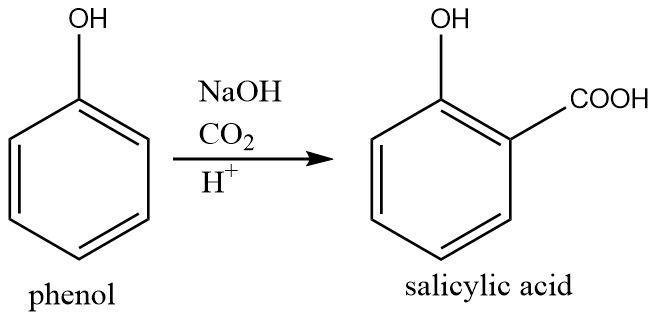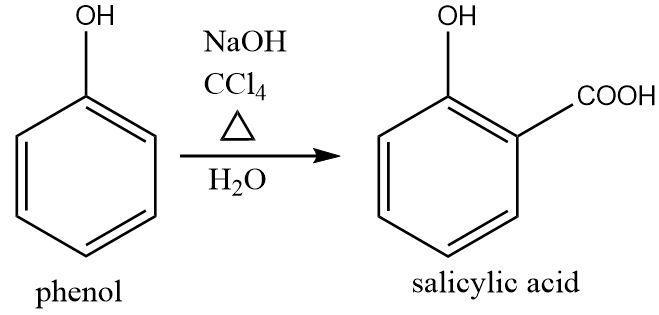
How is phenol converted to salicylic acid?
Answer
495.9k+ views
Hint :Benzene attached to a hydroxyl functional group is called phenol. Salicylic acid is a derivative of phenol itself with an additional carboxylic acid functional group attached to a position ortho to the hydroxyl group of phenol.
Complete Step By Step Answer:
Salicylic acid is an important industrial organic compound that can be derived from phenol through two different types of reactions. It contains the same structure as that of phenol with an additional carboxylic acid group $ (COOH) $ placed at the ortho position (adjacent position) of the hydroxyl group of phenol.
The two methods of converting phenol to salicylic acid are as follows:
Kolbe-Schmitt reaction: This reaction involves the conversion of acidic phenol into a phenoxide ion in presence of sodium hydroxide base. This is followed by the attack of phenoxide ion of the electrophilic carbon dioxide gas resulting in a carboxylate group getting attached at the ortho position. The reaction ends with a mild acidic hydrolysis that gives salicylic acid.
Thus it is a base facilitated carboxylation of phenol.
The overall reaction can be written as follows:
$ {\text{phenol}}\xrightarrow[{{H^ + }}]{\begin{subarray}{l}
NaOH \\
C{O_2}
\end{subarray} }{\text{salicylic acid}} $

Reimer–Tiemann reaction: This reaction involves the conversion of phenol to salicylic acid by treatment of phenol at high temperatures with carbon tetrachloride in the presence of an alkali followed by mild hydrolysis.
The reaction can be written as follows:
$ {\text{phenol}}\xrightarrow[{{H_2}O}]{\begin{subarray}{l}
NaOH \\
CC{l_4}
\end{subarray} }{\text{salicylic acid}} $

Note :
The Reimer–Tiemann reaction can be performed with both chloroform as well as carbon tetrachloride. The reaction in the presence of chloroform as a reagent gives salicylaldehyde, however that in the presence of carbon tetrachloride gives salicylic acid as the desired product.
Complete Step By Step Answer:
Salicylic acid is an important industrial organic compound that can be derived from phenol through two different types of reactions. It contains the same structure as that of phenol with an additional carboxylic acid group $ (COOH) $ placed at the ortho position (adjacent position) of the hydroxyl group of phenol.
The two methods of converting phenol to salicylic acid are as follows:
Kolbe-Schmitt reaction: This reaction involves the conversion of acidic phenol into a phenoxide ion in presence of sodium hydroxide base. This is followed by the attack of phenoxide ion of the electrophilic carbon dioxide gas resulting in a carboxylate group getting attached at the ortho position. The reaction ends with a mild acidic hydrolysis that gives salicylic acid.
Thus it is a base facilitated carboxylation of phenol.
The overall reaction can be written as follows:
$ {\text{phenol}}\xrightarrow[{{H^ + }}]{\begin{subarray}{l}
NaOH \\
C{O_2}
\end{subarray} }{\text{salicylic acid}} $

Reimer–Tiemann reaction: This reaction involves the conversion of phenol to salicylic acid by treatment of phenol at high temperatures with carbon tetrachloride in the presence of an alkali followed by mild hydrolysis.
The reaction can be written as follows:
$ {\text{phenol}}\xrightarrow[{{H_2}O}]{\begin{subarray}{l}
NaOH \\
CC{l_4}
\end{subarray} }{\text{salicylic acid}} $

Note :
The Reimer–Tiemann reaction can be performed with both chloroform as well as carbon tetrachloride. The reaction in the presence of chloroform as a reagent gives salicylaldehyde, however that in the presence of carbon tetrachloride gives salicylic acid as the desired product.
Recently Updated Pages
Why are manures considered better than fertilizers class 11 biology CBSE

Find the coordinates of the midpoint of the line segment class 11 maths CBSE

Distinguish between static friction limiting friction class 11 physics CBSE

The Chairman of the constituent Assembly was A Jawaharlal class 11 social science CBSE

The first National Commission on Labour NCL submitted class 11 social science CBSE

Number of all subshell of n + l 7 is A 4 B 5 C 6 D class 11 chemistry CBSE

Trending doubts
What is meant by exothermic and endothermic reactions class 11 chemistry CBSE

10 examples of friction in our daily life

One Metric ton is equal to kg A 10000 B 1000 C 100 class 11 physics CBSE

1 Quintal is equal to a 110 kg b 10 kg c 100kg d 1000 class 11 physics CBSE

Difference Between Prokaryotic Cells and Eukaryotic Cells

What are Quantum numbers Explain the quantum number class 11 chemistry CBSE




